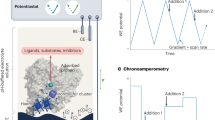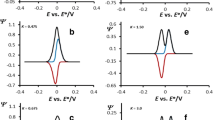Abstract
Acquisition of the direct electrochemical response of protein is the cornerstone for the development of the third generation of electrochemical biosensors. In this work, we developed a nanocluster-assisted protein-film voltammetry technique (NCA-PFV) which can achieve the acquisition of the electrochemical signal and maintain the activity without affecting of the protein’s structure. With this strategy, a lipid bilayer membrane is used to immobilize the membrane protein so as to maintain its natural state. Copper nanoclusters with a size smaller than most proteins are then used to function at sub-protein scale and to mediate the electron hopping from the electroactive center of the electrode. As a model, the direct electrochemical signal of cyclooxygenase (COX) is successfully obtained, with a pair of well-defined redox peaks located at −0.39 mV and −0.31 mV, which characterize the heme center of the enzyme. Its catalytic activity towards the substrate arachidonic acid (AA) is also retained. The detection range for AA is 10–1000 μM and the detection limit is 2.4 μM. Electrochemical monitoring of the regulation of the catalytic activity by an inhibitor DuP-697 is also achieved. This work provides a powerful tool for the fabrication of enzyme-based electrochemical biosensors, and is also of great significance for promoting the development and application of next-generation electrochemical biosensors.
Graphical abstract








Similar content being viewed by others
References
Armstrong FA, Heering HA, Hirst J. Reaction of complex metalloproteins studied by protein-film voltammetry. Chem Soc Rev. 1997;26:169–79.
Zhang W, Li G. Third-generation biosensors based on the direct electron transfer of proteins. Anal Sci. 2004;20:603–9.
Scheller FW, Schubert F, Neumann B, Pfeiffer D, Hintsche R, Dransfeld I, et al. Second generation biosensors. Biosens Bioelectron. 1991;6:245–53.
Armstrong FA. Insights from protein film voltammetry into mechanisms of complex biological electron-transfer reactions. J Am Chem Soc. 2002;5:661–7.
Bostick CD, Mukhopadhyay S, Pecht I, Sheves M, Cahen D, Lederman D. Protein bioelectronics: a review of what we do and do not know. Rep Prog Phys. 2018;81:026601.
Pereira AR, Sedenho GC, Souza JCPD, Crespilho FN. Advances in enzyme bioelectrochemistry. An Acad Bras Cienc. 2018;90:825–57.
Breslmayr E, Laurent CVFP, Scheiblbrandner S, Jerkovic A, Heyes DJ, Oostenbrink C, et al. Protein conformational change is essential for reductive activation of lytic polysaccharide monooxygenase by cellobiose dehydrogenase. ACS Catal. 2020;10:4842–−53.
Mader SL, Lopez A, Lawatscheck J, Luo Q, Rutz DA, Gamiz-Hernandez AP, et al. Conformational dynamics modulate the catalytic activity of the molecular chaperone Hsp90. Nat Commun. 2020;11:1410.
Naumann RLC, Geiss AF, Steininger C, Knoll W. Biomimetic Membranes for multi-redox center proteins. Int J Mol Sci. 2016;17:330.
Shen Y, Saboe PO, Sines IT, Erbakan M, Kumar M. Biomimetic membranes: a review. J Membr Sci. 2014;454:359–81.
Ryu H, Fuwad A, Yoon S, Jang H, Lee JC, Kim SM, et al. Biomimetic membranes with transmembrane proteins: state-of-the-art in transmembrane protein applications. Int J Mol Sci. 2019;20:1437.
Li G, Miao P. Electrochemical analysis of proteins and cells. Berlin: Springer Berlin Heidelberg; 2012.
Modugno G, Ménard-Moyon C, Prato M, Bianco A. Carbon nanomaterials combined with metal nanoparticles for theranostic applications. Br J Pharmacol. 2015;172:975–91.
Zhao Y, Hua Y, Hou J, Jia Z, Zhong D, Zhou S, et al. Electrochemical biointerface based on electrodeposition AuNPs on 3D graphene aerogel: direct electron transfer of cytochrome c and hydrogen peroxide sensing. J Electroanal Chem. 2019;842:16–23.
Yu C, Wang L, Li W, Zhu C, Bao N, Gu H. Detection of cellular H2O2 in living cells based on horseradish peroxidase at the interface of au nanoparticles decorated graphene oxide. Sensors Actuators B Chem. 2015;211:17–24.
Reuillard B, Ly KH, Hildebrandt P, Jeuken LJC, Butt JN, Reisner E. High performance reduction of H2O2 with an electron transport decaheme cytochrome on a porous ITO electrode. J Am Chem Soc. 2017;139:3324–7.
López-Bernabeu S, Huerta F, Morallón E, Montilla F. Direct electron transfer to cytochrome c induced by a conducting polymer. J Phys Chem C. 2017;121:15870–9.
Zou L, Qiao Y, Zhong C, Li CM. Enabling fast electron transfer through both bacterial outer-membrane redox centers and endogenous electron mediators by polyaniline hybridized large-mesoporous carbon anode for high-performance microbial fuel cells. Electrochim Acta. 2017;229:31–8.
Luong JHT, Glennon JD, Gedanken A, Vashist SK. Achievement and assessment of direct electron transfer of glucose oxidase in electrochemical biosensing using carbon nanotubes, graphene, and their nanocomposites. Microchim Acta. 2017;184:369–88.
Aires A, Lopez-Martinez E, Cortajarena AL. Sensors based on metal nanoclusters stabilized on designed proteins. Biosensors. 2018;8:110.
Wu Z, Tang J, Cheng Z, Yang X, Wang E. Ion channel behavior of supported bilayer lipid membranes on a glassy carbon electrode. Anal Chem. 2000;72:6030–3.
Menter DG, Schilsky RL, Dubois RN. Cyclooxygenase-2 and cancer treatment: understanding the risk should be worth the reward. Clin Cancer Res. 2010;16:1384–90.
Williams CS, Mann M, DuBois RN. The role of cyclooxygenases in inflammation, cancer, and development. Oncogene. 1999;18:7908–16.
Kam PCA, See AU. Cyclo-oxygenase isoenzymes: physiological and pharmacological role. Anaesthesia. 2000;55:442–9.
Thuresson ED, Lakkides KM, Rieke CJ, Sun Y, Wingerd BA, Micielli R, et al. Prostaglandin endoperoxide H synthase-1: the functions of cyclooxygenase active site residues in the binding, positioning, and oxygenation of arachidonic acid. J Biol Chem. 2001;276:10347–57.
Smith WL, DeWitt DL, Garavito RM. Cyclooxygenases: structural, cellular, and molecular biology. Annu Rev Biochem. 2000;69:145–82.
Choi EM, Kim SR, Lee EJ, Han JA. Cyclooxygenase-2 functionally inactivates p53 through a physical interaction with p53. BBA-Mol Cell Res. 1793;2009:1354–6.
Zhu X, Liu S, Cao J, Mao X, Li G. Switchable DNA wire: deposition-stripping of copper nanoclusters as an “ON-OFF” nanoswitch. Sci Rep. 2016;6:19515.
Nandini S, Nalini S, Niranjana P, Melo JS, Suresh GS. Metal-ion co-ordination assembly based multilayer of one dimensional gold nanostructures and catalase as electrochemical sensor for the analysis of hydrogen peroxide. Sensors Actuators B Chem. 2017;245:726–40.
Murray RW. Chemically modified electrodes. New York: Marcel Dekker; 1984.
Yun Y, Lu Z, Yang J, Liang T, Xiao G, Qiao Y, et al. Electrochemical analysis of specific catalase activity during development of Aspergillus flavus and its correlation with aflatoxin B1 production. Food Chem. 2021;337:127978.
Author information
Authors and Affiliations
Corresponding author
Ethics declarations
Ethics declarations
This work was supported by the Scientific Research Projects of Health Commission in Hainan Province [1901031041A2001], and the authors declare no competing financial or non-financial interests. The human plasma study was conducted according to the principles expressed in the Declaration of Helsinki and was approved by the Ethical Committee of Haikou People’s Hospital. All subjects provided written informed consent to participate.
Additional information
Publisher’s note
Springer Nature remains neutral with regard to jurisdictional claims in published maps and institutional affiliations.
Supplementary Information
ESM 1
(PDF 681 kb)
Rights and permissions
About this article
Cite this article
Li, W., Yu, X. & Huang, H. Nanocluster-assisted protein-film voltammetry for direct electrochemical signal acquisition. Anal Bioanal Chem 413, 1665–1673 (2021). https://doi.org/10.1007/s00216-020-03130-5
Received:
Revised:
Accepted:
Published:
Issue Date:
DOI: https://doi.org/10.1007/s00216-020-03130-5




